17 January. We left Motel 6 in Lebec as it was getting light at 07:00 and drove up to Mount Pinos with some trepidation. A local newspaper in the motel had a front page all about chaos on the roads the previous weekend with 'snow bunnies' from the big cities flocking to the mountains, blocking the roads and causing long delays. The road started climbing and soon there were patches of snow beside it. A sign warning the road was only passable for chains was slightly disconcerting but as it seemed fine we took it as an advisory and continued cautiously. As we drove higher the snow became thicker and in places was piled up beside the road where a snowplough had cleared it. at about 08:00 we reached the end of the road, a car park at the Nordic Base at 8,300 feet above sea level and surrounded by fairly open conifer forest. There were only about a dozen vehicles there and we noted that none of them had chains. We bought a $5 Adventure Pass that allowed us to stop and walk around and a $2 trail map, although as all trails were under at least a foot of snow it was not money well spent. We climbed up to the nearest ridge, at times through knee deep snow which made it hard work. We were at about 8,500 feet (the summit of Mount Pinos is 8,850). It was superb to be high up in the mountains, despite not reaching a natural viewpoint and their being few birds in evidence - just 2 Steller's Jays, a flock of Pygmy Nuthatches and an endearing Mountain Chickadee. We returned to the car park and walked down the road for a couple of kms seeing a few more nuthatches and eventually an impressive White-headed Woodpecker. It had been our main target for the area and traffic was building up making walking the road less pleasant. We returned to the car to find the car park overflowing, it was only 10:00. We drove down the road and most of the pull-ins were filling up. We stopped at a couple where the laying snow wasn't so thick in the hope of seeing some birds feeding on the ground but couldn't find any. Four White-throated Swifts overhead and a pair of Western Bluebirds were some compensation as was a Golden-crowned Sparrow and a flock of Oregon Juncos by some houses lower down.
 |
| snow on the higher slopes of Mount Pinos |
 |
| walking in the snow was hard going |
 |
| tangled tree |
 |
| Mountain Chickadee, one of the few birds seen, taken a second too late |
 |
| Raven at Mount Pinos |
 |
| Mount Pinos Nordic Base |
 |
| the lower slopes were still covered in snow |
 |
| Golden-crowned Sparrow |
 |
| the dullest American Sparrow we saw, by some distance |
 |
| Mountain Plover at 110J, one of the closer of the 60 seen |
 |
| magnified rather too much |
 |
| uncultivated land nearby |
 |
| Joshua Tree at Saddleback Butte |
 |
| view from Saddleback Butte State Park |
 |
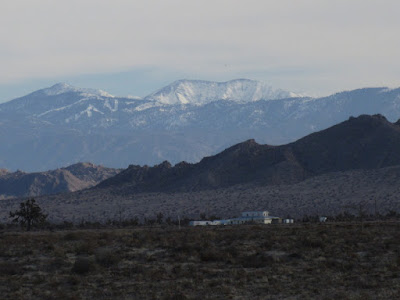 |
| more thrasher habitat |
 |
| tracks in the sand, we thought most likely roadrunner |
 |
| a film (TV show or advert) was being shot outside the distant building |
18 January. We left Beaumont at first light and drove south up into the San Jacinto Mountains. There was snow on the ground but not as much as at Mount Pinos. We tried Lake Fulmor which was mainly frozen, walked the start of the Black Mountain Trail where Matt found a Townsend's Solitaire which dropped off its perch on the top of a dead tree just as I got my binoculars onto it. A 4WD made a lot of noise passing and 5 minutes later even more having turned back (the track was quite icy in places). Fortunately the solitaire reappeared on top of another dead tree, very nice. we spent an hour or so walking around Hurley Creek camp ground (it was almost deserted) and Matt picked a Slate-coloured Junco out from amongst 30+ Oregons. Otherwise it was quiet. We tried Lake Hemet where an adult Bald Eagle was impressive, if distant, and continued down out of the mountains to Palm Springs.
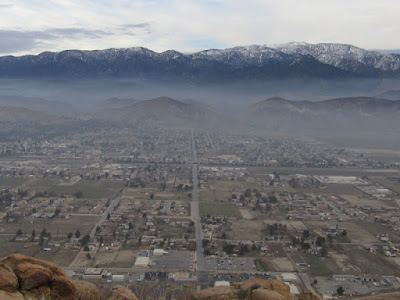 |
| early morning driving up into the mountains |
 |
| view from near Lake Fulmor |
 |
 | ||||||||||||||
| Acorn Wodpeckered tree, we found the shell of an acorn in one of the holes |
 |
| not as much snow on the hills as there was at Mount Pinos |
 |
| Steller's Jay at Hurley Creek |
 |
 |
| House Finches |
 |
| Mountain Chickadee, no better than my previous effort |
 |
| Northern Flicker at Hurley Creek |
 |
| we had a good ten minutes for woodpeckers |
 |
| Hairy Woodpecker at Hurley Creek |
 |
| Nuttall's Woodpecker |
 |
| leaving the mountains |
 |
| distant views of Palm Springs |
We arrived at the Living Desert Museum and spend a very enjoyable couple of hours in the car park watching Costa's Hummingbirds. It was then a short drive to our Motel 6 in Palm Canyon Drive.
 |
| Costa's Hummingbird in the Living Desert Museum car park, it was almost the first bird we saw |
 |
| tiny but quite aggressive, while we were watching it shot off after an overflying rival and chased it away |
 |
| the throat 'shield' was reminiscent of Superb Bird-of-paradise |
 |
| taken at 1/640th second and still its wings are completely blurred |
 |
| the purple head and throat were stunning when tehy caught the light |
 |
| House Finch |
 |
| Northern Mockingbird |
 |
| Black Phoebe |
 |
| Phainopepla |
 |
| Say's Phoebe |
19 January. We left our motel at 06:45 and drove to Big Morongo arriving at 07:10. The car park was full of birds with White-breasted and Red-breasted Nuthatch, Red-breasted Sapsucker and Ladder-backed Woodpecker in quick succession. We wandered along the marsh boardwalk seeing Lincoln's Sparrow and Marsh Wren from it and several California Thrashers in a canyon, a very enjoyable two hours.
 |
| palm tree in Big Morongo car park |
 |
| it was easy to imagine how the area could be superb for migrants |
 |
| somewhere we felt |
 |
| an inquisitive California Scrub Jay |
 |
| it had clearly been fed regularly |
 |
| and its confiding nature won me over to part with some biscuits |
 |
| a showy California Thrasher |
 |
| Hermit Thrush, still impressing |
 |
| Ladder-backed Woodpecker |
 |
| Cactus Wren |
 |
| Greater Roadrunner |
 |
| fortunately it had not run far |
 |
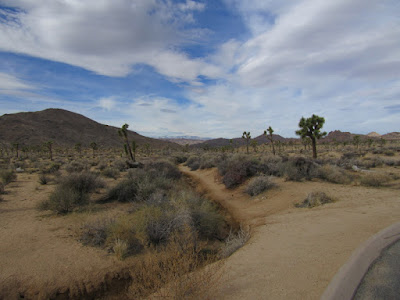 |
| Joshua Tree National Park |
 |
 |
| Hidden Valley |
 |
| inside Hidden Valley |
 |
 |
| popular with rock climbers |
 |
| and Rock Wrens |
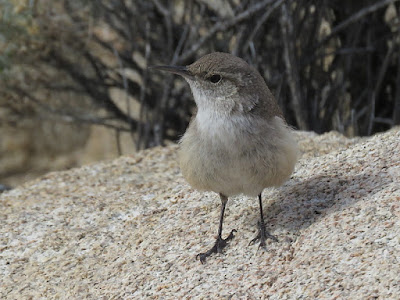 |
 |
| I know which I'd rather see |
 |
 |
 |
| Joshua Trees |
 |
 |
| Cactus Garden |
 |
| Sagebrush Sparrow in the more open scrubby desert |
 |
| very similar to and recently split from the Bell's Sparrows we had seen on the Soda Lake Road |
 |
| Red-tailed Hawk |
 |
| Le Conte's Thrasher |
 |
| a very pleasant but unexpected surprise |
 |
 |
| Smoke Tree Wash |
We drove down Box Canyon where a quick stop produced Black-tailed Gnatcatcher and reached North Shore as the sun dropped behind the Santa Rosa Mountains. Our first look at the Salton Sea produced many Ring-billed and California Gulls, 4 Gambel's Quail and a pair of Red-breasted Mergansers. We drove south to Brawley, checking into the Desert Inn Motel where we had arranged to meet Guy McCaskie at 06:15.
 |
| North Shore as the sun set. |
 |
 |
| a superb sunset on another successful day |






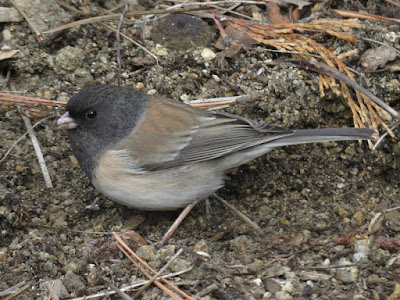











No comments:
Post a Comment
Note: only a member of this blog may post a comment.